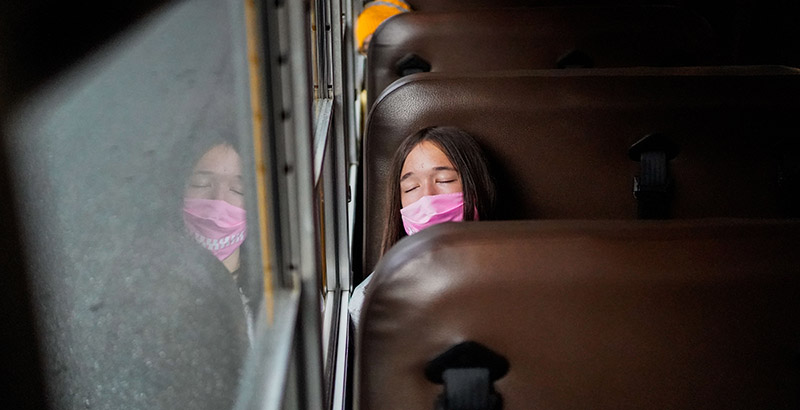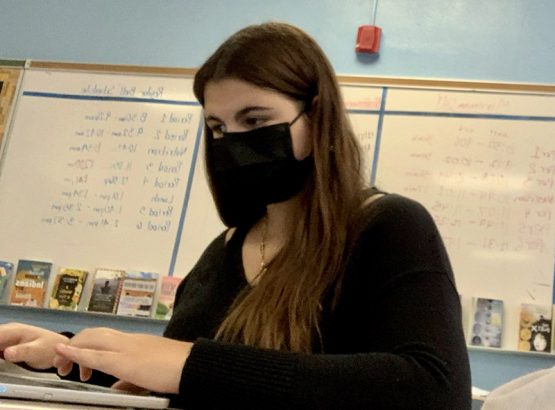More Productivity or ‘Zombied Out’ Students? Congress Ponders Permanent Daylight Saving Time, But Sleep Experts Say They’ve Got it Backwards
Congress Mulls End of Clock Changes, But Experts Warn of Impact on Student Sleep

Get stories like this delivered straight to your inbox. Sign up for The 74 Newsletter
As a member of PBS NewsHour’s Student Reporting Lab at Venice High School, near Los Angeles, Zoe Woodrick often stays at school past 5 p.m. recording podcasts and videos.
When her interviews run late in the winter months, the sun is already setting over the Pacific, less than two miles away. Her walk home takes at least 20 minutes on “busy and chaotic streets,” and she doesn’t feel safe taking shortcuts through alleys.
“It can be annoying when it’s dark and I’m walking home, or if I have to wait for someone to pick me up, I feel uncomfortable standing there,” said the ninth grader. “If it’s still light out, that’s a positive for me.”

Woodrick, like many teens, says permanent daylight saving time would better accommodate her busy life and brushes off concerns about getting up for school in the dark. And if the U.S. House embraces the idea as enthusiastically as the Senate, the nation could soon see the end of its annual spring forward/fall back ritual.
On March 15, the Senate unanimously passed the Sunshine Protection Act, which would go into effect in November 2023. Proponents, including the bill’s sponsor, Florida Republican Sen. Marco Rubio, say the change would reduce crime, prevent childhood obesity and boost the economy. Senate education Chair Patty Murray of Washington voiced her enthusiasm during a radio show in November.
“It’s crazy that every fall we interrupt everybody’s sleep schedule,” she said. “Nobody knows what time it is for weeks on end after that, and it’s dark at 4:30 [p.m.] in my state.”
It’s unclear how quickly the House will take up the bill. Following an energy and commerce subcommittee hearing earlier this month, Rep. Frank Pallone, a New Jersey Democrat who chairs the full committee, said he hopes lawmakers can soon “end the silliness of the current system.” But some members, including Rep. Pramila Jayapal — also of Washington — don’t appear as certain that permanent daylight saving time is the way to go.
Dave Dougherty, executive director of the National High School Athletic Coaches Association, said he hopes the House takes more time to consider other perspectives.
“One of the biggest challenges is kids who are overly tired and have not gotten enough rest,” he said. “It’s complicated. It’s more than a simple fix.”
Sleep researchers agree ending the biannual clock adjustment makes sense, but disagree about how: Adolescents, they say, need more daylight in the morning, not the evening — the reason why there’s been a push in recent years to start high school classes later. The U.S. tried permanent daylight saving time in the 1970s to save energy, but later scrapped the law because people didn’t like getting up before sunrise.
“We may shift the time of day, but our internal clocks are still responsive to morning light,” said Wendy Troxel, a behavioral and social scientist and sleep medicine specialist at the RAND Corp. She said the Senate didn’t consider the research in making their decision. “More golf and summer barbecues sound delightful, but think about December.”
In puberty, adolescents’ sleep cycles shift. It’s harder for them to wind down at 8 or 9 p.m., and they might not get drowsy until 10 or 11 p.m. Many teens already don’t get enough sleep and some research shows Black adolescents get less than their white peers. Inadequate sleep has also been linked to anxiety, anger and depression.
With reports that the pandemic has contributed to mental health problems, experts say a permanent switch to standard time would be a healthier option.
“We’ll have a bunch of zombied out people in the mornings,” said Dr. Rafael Pelayo, a sleep specialist and clinical professor at Stanford University, predicting the need for artificial light boxes, more warning signs at crosswalks and police on the streets.
The ‘ability to wake up’
Pelayo is on the board of Start School Later, a national organization that advocates for pushing start times back for older students to 8:30 a.m. — often an hour later than many high schools start now. Districts in 46 states have made the shift, and California passed a law, going into effect this fall, that delays start times to at least 8 a.m for middle school and 8:30 a.m. for high school.
Terra Ziporyn Snider, the organization’s executive director, said it’s likely more states could follow California’s lead if the bill becomes law. Legislation this session is on its way to New York Gov. Kathy Hochul and has been introduced in Tennessee and Connecticut.
Research shows “modest” academic benefits from pushing start times to at least 8:30 a.m., Troxel said, and allowing teens more time to snooze already has bipartisan support. Rubio has endorsed later start times, and progressive Democrat Rep. Alexandria Ocasio-Cortez of New York tweeted she’s still angry that her high school’s trigonometry and pre-calculus classes started at 7:20 a.m.
But year-round daylight saving time “would work against later school start times,” especially in northern regions of the country and on the western edges of time zones, where the sun rises later, said Dr. Beth Malow, a professor of neurology and pediatrics at Vanderbilt University.
“I honestly think legislators don’t understand it,” Malow said. “Kids will be going to school in the dark. That affects their getting enough sleep and their ability to wake up and be alert for school.”
The Congressional push has yet to meet with concerted opposition from educators or their advocates in Washington. The National PTA, the nation’s two largest teachers unions and the National School Boards Association support efforts to make standard time permanent.
‘One more cup of coffee’
If the bill becomes law, students say they’ll adjust.

Sara Falluji, a junior at Paul Laurence Dunbar High School in Lexington. Kentucky, thinks more light in the evening will benefit — not harm — students’ moods.
“Students are inside the school building for seven to eight hours on average,” she said. “That means minimal time spent outside, something that is really important for the mental and physical health of students.”
She also sees an upside for young drivers. Driving to school before sunup can help teens with learner’s permits clock the required number of nighttime driving hours, she said.
In general, however, teens are thinking about what they’ll be able to do after school with more daylight.

Raima Dutt, another Kentucky student, plays golf, a fall sport. She agreed she’d prefer to have more light at the end of the day.
“As the season goes on, we have to rush our practices and games to finish before the sun sets,” said the sophomore at duPont Manual High School in Louisville. She added that darkness at dinner time makes her feel rushed in the evenings.

Devin Walton, a ninth-grader at South High School in Torrance, California, likes science and said he doesn’t have a hard time paying attention in biology, his first class of the day. He’s also a runner and has track meets that can stretch into the early evening.
“I would feel pressure to leave work and rush home to make sure he’s not riding his bike or walking home in the dark,” said his mother Krystal Walton. “I feel like it’s just one hour. We might make one more cup of coffee.”
Get stories like these delivered straight to your inbox. Sign up for The 74 Newsletter

;)
